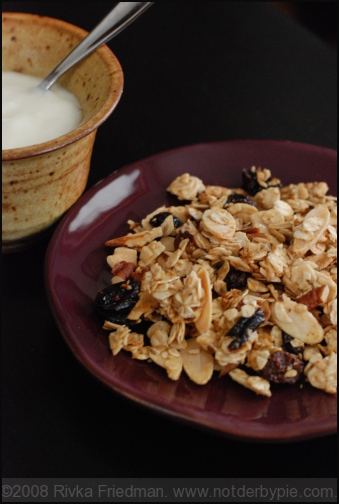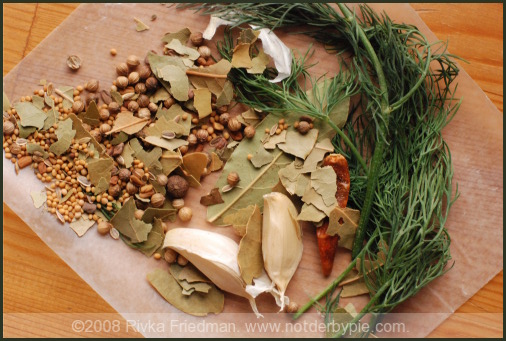 Folks, I'm finding it hard to contain my excitement about NDP's second-ever guest post. Guess who wrote it? MY MOM!
Folks, I'm finding it hard to contain my excitement about NDP's second-ever guest post. Guess who wrote it? MY MOM!
That's right: in the post below, NDP Ima tells you all about easy-to-make, hard-to-stop-eating pickles. You'll see from her intro paragraph where I got my taste buds. These pickles are salty, tangy, and really bright from the addition of fresh dill. So read up -- then go make some pickles!
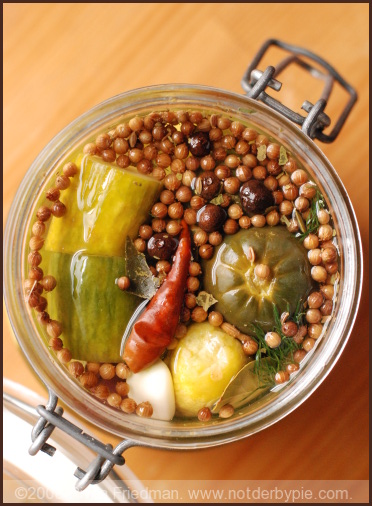
I am really not a salt lover. I don’t use much when I cook, and in restaurants great food that’s well-seasoned is often too salty for my taste. I don’t care for chips or french fries, and I prefer nuts spicy or au naturel. Nonetheless, I do love briny salty things – olives, capers, and sour pickles. So when I was leaving town for a long weekend and had a lot of small cucumbers that wouldn’t last until my return, I decided to try my hand at some pickles. I wanted spicy, garlicky, dill pickles that would make themselves in the refrigerator while I was gone. I remembered the ones a family friend used to make with cucumbers from his garden and my dad’s. He didn’t use shortcuts, though – he put his pickles in huge crocks of brine and alum in the basement for weeks.
I cut the cukes into thick, chunky slices and placed them in a quart jar with pickling spices and garlic. I didn’t have any fresh dill, so my first batch just had dill seed from the pickling spice, but it still tasted authentic. I prepared the vinegar brine and filled the jar, leaving it upside down on the counter overnight. The next morning, before rushing to the airport, I put the jar in the frig. When I returned four nights later, the pickles were done to perfection!
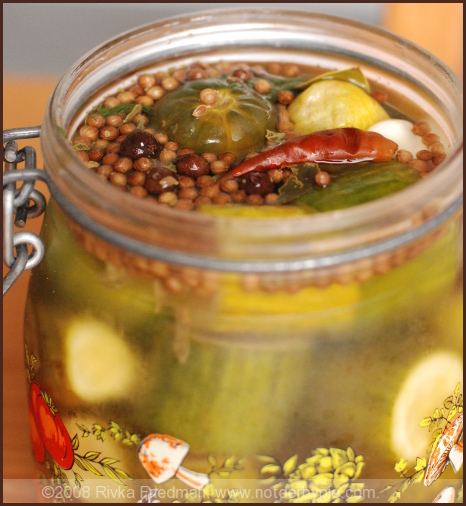
The recipe below is really more of a method – you can vary the ingredients, and the size of your jars and your cucumbers will determine your quantities. As long as you maintain the proportions of ¾ cup of vinegar and ¼ cup of kosher salt per quart of boiled and cooled water, your brine will work and you’ll have great pickles in a matter of days. Try this with green tomatoes if you have them in your garden, with blanched cauliflower, small sweet peppers, or blanched pearl onions. Add onions or hot peppers for extra kick. I used just one hot pepper to enhance the spicy flavor. I made a second batch with fresh dill sprigs, blanched carrots, and a few kalamata olives in addition to the cukes.
They’re not quite finished as a I write this, but they look so good I can’t wait to sample them!
If you like sweet pickles instead of sour, substitute sweet pickling spices, cloves, and allspice, use cider vinegar instead of white vinegar, and add sugar (1/2 cup to ¾ cup) to your brine.
Your pickles will keep about four months in the refrigerator. If you seal your finished pickle jars with a canning process, they will keep on the shelf indefinitely. Open jars should be refrigerated.
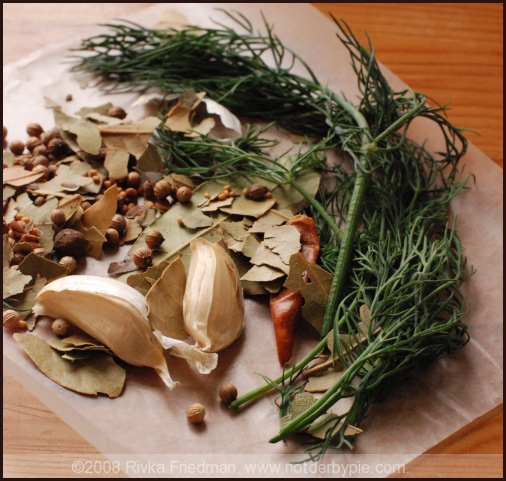
Refrigerator Dill Pickles
1 dozen or more pickling cucumbers or small English cucumbers
4-8 cloves garlic, peeled and cut in half
2-3 tablespoons pickling spice (the brand I used had dill seed, mustard seed, celery seed, coriander, ginger, black peppercorns, bay leaves, and red pepper)
A few sprigs of fresh dill
1 small dried hot pepper, or a fresh hot pepper cut in half and seeds removed (optional)
1 quart water boiled and cooled
¾ cup white vinegar
¼ cup salt (kosher salt works well, but sea salt or table salt are also fine)
A pinch of sugar (if desired – I omitted)
Use one or two quart jars or a gallon jar, depending on how your cucumbers fit into the jar. The amounts of spices are for one gallon jar or two quart jars, but you can modify this according to taste and the quantity of pickles you want to make. Place one tablespoon of pickling spice, half the dill and half the garlic in the bottom of the jar. If using slender or English cucumbers, you can cut them into thick chunks/slices and they will be ready in less time. If you use larger cucumbers, you can pickle them whole and cut them into lengthwise quarters when you serve them. Pack the cucumbers tightly into the jar(s). When you have added most of the cucumbers, add half of the remaining spices and garlic. When all the pickles are in the jar, add the last of the spices. If using the pepper, place it in the middle layer.
When the jar is full of cucumbers and spices, stir the salt into the vinegar. Pour the mixture into the boiled water and stir to finish dissolving the salt. The water does not have to reach room temperature, since it will continue to cool as you make the brine. Fill the jar to the brim with brine. Close the jar tightly with its lid. Invert the jar into a bowl and leave it outside the refrigerator. After one day, turn the jar upright. Check to see how pickled the cucumbers are. If you used the smaller, slender cukes, it is probably time to refrigerate the pickles. They will be completely done in another three or four days. If you used larger cucumbers, leave them out for another day or two. Check for doneness according to your preferences – if you prefer half-sour, they should be edible after just one-two days.
When the pickles are as done as you like them, you can pour out half the brine, leaving as many spices in the jar as possible. Replace the removed liquid with a mixture of plain boiled water and vinegar. For each cup of boiled, cooled water, add two tablespoons of white vinegar. Fill the jar to the top again and refrigerate. You can also remove the hot pepper if you don’t want the pickles to get spicier over time.
 This is the kind of recipe I live for. It reminds me of those really good bran muffins you find at local coffee shops, with the nutty, wholesome flavors and tops that crust around the edges and never are perfectly round. It's got a more well-defined crumb than carrot kugel, but it's not as sweet as carrot cake, and grated zucchini lends it sophistication. Not that this is a snobby loaf -- just the opposite. It takes about 5 minutes to mix together, and the 80-minute baking time lets you actually get something else done while you wait. I brought it to our pre-Yom Kippur meal on Sunday afternoon, but it'd make a phenomenal breakfast or afternoon snack.
This is the kind of recipe I live for. It reminds me of those really good bran muffins you find at local coffee shops, with the nutty, wholesome flavors and tops that crust around the edges and never are perfectly round. It's got a more well-defined crumb than carrot kugel, but it's not as sweet as carrot cake, and grated zucchini lends it sophistication. Not that this is a snobby loaf -- just the opposite. It takes about 5 minutes to mix together, and the 80-minute baking time lets you actually get something else done while you wait. I brought it to our pre-Yom Kippur meal on Sunday afternoon, but it'd make a phenomenal breakfast or afternoon snack.  Folks, I'm finding it hard to contain my excitement about NDP's second-ever guest post. Guess who wrote it? MY MOM!
Folks, I'm finding it hard to contain my excitement about NDP's second-ever guest post. Guess who wrote it? MY MOM!


 D and I had people over Friday night. As of Thursday, I not only had done no cooking, I hadn't even figured out my menu. Now, I'm not one to plan these things all too far in advance -- but 24 hours is not much time to plan, shop, and make food for a dinner party. Not impossible, but not ideal.
D and I had people over Friday night. As of Thursday, I not only had done no cooking, I hadn't even figured out my menu. Now, I'm not one to plan these things all too far in advance -- but 24 hours is not much time to plan, shop, and make food for a dinner party. Not impossible, but not ideal. 
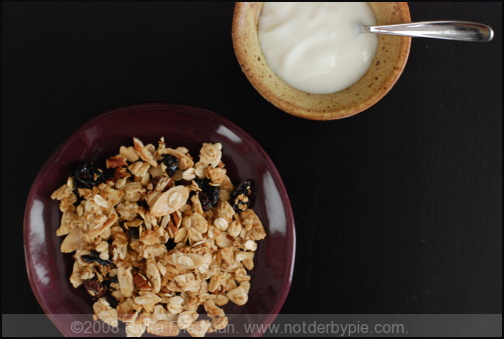 Ahh lovely readers, I've missed you! I've been posting sporadically at best for the past month, because work has been absolutely insane and I haven't had time to even enter the kitchen, let alone write about it. That last post on zucchini soup was my lame attempt to give you reading material while I was at work, so as not to abandon you completely -- but I unwittingly passed along a post from last year, just before my Alaska cruise, and let you all think I was headed on a fabulous vacation. Not so! I spent Labor Day.....well, laboring. At the office. Until very late. But now all that should be behind me because we signed off on our research yesterday, and all that's left to do is write the accompanying speech. I'm hoping today is the beginning of my re-entry into my favorite room of the apartment. Cross your fingers for me, will you?
Ahh lovely readers, I've missed you! I've been posting sporadically at best for the past month, because work has been absolutely insane and I haven't had time to even enter the kitchen, let alone write about it. That last post on zucchini soup was my lame attempt to give you reading material while I was at work, so as not to abandon you completely -- but I unwittingly passed along a post from last year, just before my Alaska cruise, and let you all think I was headed on a fabulous vacation. Not so! I spent Labor Day.....well, laboring. At the office. Until very late. But now all that should be behind me because we signed off on our research yesterday, and all that's left to do is write the accompanying speech. I'm hoping today is the beginning of my re-entry into my favorite room of the apartment. Cross your fingers for me, will you?